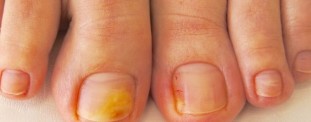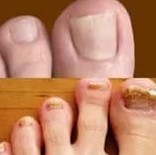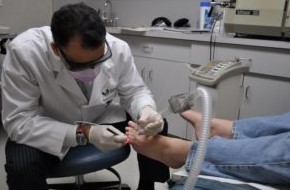Fungal infection of toe nails is now widely used. There are different types of nail fungus of the feet, and the treatment depends on the type of the pathogen. The cause of the disease is not a lack of hygiene, but that many are forced to-day to find in the shoe.

The essence of the infection and the development of the disease is in contact with fungal spores from the skin of the soles of the feet. The micro-organisms penetrate into the various cracks, bumps, roughness of the skin. In almost all cases, the fungus on the nails, which immediately began to acquire a dirty appearance.
The main types of
The itching, the change of the nail plate is a common symptoms of the disease, which are celebrated in all its forms. There are more specific signs depending on the type of pathogen. So what kinds of mildew exist?
Dermatophyte
This form develops in contact with pathogens Trichophyton, Microsporum and Epidermophyton.
A person is confronted with the following symptoms:
- the appearance of the greys, yellows, streaks of plates. First of all, the spots appear on the same nail, passing gradually to nearby;
- the nail starts to gradually lag behind the lodge.
Mold
Mold able to hit not only products, but also the skin and nails of man. The main symptom of this form of fungal pathology is a change in color.
Healthy pink tint they become unpleasant black, brown or green. Not less power to the sign is the appearance of blackheads, spots.

Yeast
Appears because of the contamination by the fungus Candida. A negative characteristic is the greater the probability of a defeat stop. The main symptoms are:
- The surface of the nail is much thinner, why they quickly break.
- Nail plate to change color and structure.
- By the development of the disease are the highest of exfoliation.
- The fingers are swollen continuously, acquire a red colour.
This infection spreads through the humidity. It is for this reason, it is important to comply with certain preventive measures during the visit of pools, baths, the soul.
Classification according to stage of development
To assign the most effective treatment, the physician must determine what is the degree of development reached the disease, that is, to correctly define the stage of the fungal infection of the feet. According to the evolution of the infection pathology is beginning to spread not only in the vicinity of the nails, but also on the skin, affecting the entire foot.

Forms of the disease on the basis of the stage of its development:
- Normotroficheskie, during which we observe a change of color of the fingernails, scratches appear, but the form itself does not change. This is the initial phase of the infection.
- Hypertrophic, which changes the nail. It is very easy to use, is thin, and generate the patient of huge downsides.
- Atrophic. The plate in this case, it is significantly more thin, it tarnishes, it changes shape, the nail is bent and destroyed quickly. At this stage, the nail plate begins to move away from the lodge. The treatment here is fairly heavy, as the disease begins to develop in the course of the form.
Improvement of the therapy
Get rid of the disease with the help of a good therapy. It depends on the species of fungus and will be necessary to rely on the stage of the disease.
The doctor will perform a medical exam professional, defines the shape and the type of fungus, studying the individual characteristics of the organism, and determines the treatment.
The choice of a schema
The medicine offers three main plans of treatment – integrated system and the external processing means. In the first case, we suppose that the receipt of medicines in the form of tablets or capsules. Many of them have many side effects.
During the treatment the treatment is prescribed not only tablets, but the medication. In the exterior, stresses, the minimum of side effects, because this model is more preferable.
An important moment for the external treatment – help is only in the initial phase of the disease, it is so hit less than a third of the nail plate and no more than two toes.

During a treatment practically all the steps and all the forms are named plans different external treatment methods. It comes to creams, varnishes and solutions. The varnish has an action exclusively on nail fungus of the feet, without affecting nearby tissue.
Among the outdoor facilities of treatment are often used in different creams. They do not eliminate all the symptoms, but also to soften and moisturize the nails, reducing the indicators of discomfort. Regardless of the method of treatment of the fungus with a drug, it is very important to follow the instructions of the specialist and the drug. Just so that you can get the most positive result of the treatment. Only in this way, the treatment tool is to provide an antifungal effect and antibacterial action.
The number of mark-up and techniques depends on the preparation and the type of fungus and the form of its development. Usually, it is two to three times per day.
If you use external processing tools to the fungus before each application of the penalty of photographing with the aid of special tools keratinized sites. This will soul the ability of the drug, will help you a lot faster to achieve positive effects, regardless of the species of fungus.
To summarize
The total duration of therapy of the yeast infection is on average only 6 months after that, there is growth of healthy, rejuvenated nail plate. On the achievement of such a result, the treatment is usually does not finish, you must continue until you reach the resistant effect and not be completely avoided thanks to a recurrence of the disease.






























